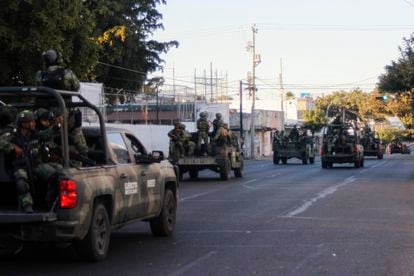
There was no way to stop Ovidio Guzman, alias The mouse, the drug dealer’s son El Chapo Guzman, without remembering his failed capture, a little over three years ago, in his city, Culiacan. The Government of Mexico explained this Friday that it had been following Guzman and his group, Los Chapitos, a faction of the Sinaloa Cartel, for six months. To avoid scenes like those of 2019, in which drug hitmen opened fire in the heart of the city after Guzman’s arrest, the authorities waited, as explained by the president, Andres Manuel Lopez Obrador. This time, as Defense Secretary Luis Crescencio Sandoval has insisted, the Army was waiting. The cost has been high; 29 dead during the operation, 10 of them military, but the tone that both have used is one of triumph and duty accomplished.
The fall of Guzman, required by the United States justice for drug trafficking, closes the fiasco of 2019, his failed capture, but opens up a number of questions. The first, the future of the capo. Lopez Obrador has explained that extradition is possible, although he has cooled any expectations that it would happen in a short time. The Prosecutor’s Office has opened an investigation against him for alleged crimes committed yesterday, attempted murder, possession of weapons… Guzman faces a path similar to that of his father’s old collaborator, Rafael Caro Quintero, arrested in July, also wanted north of the River Bravo.
The second question that opens the capture of El Raton points to the path that the authorities followed to arrest him. General Sandoval has implied that they found him by pure chance, but Lopez Obrador has hinted that the authorities waited for Guzman to be in an isolated place, far from the center of Culiacan, during low traffic hours. The president has also denied any help from the United States, operational or intelligence. However, official sources confirmed to this newspaper on Thursday that there had been an exchange of information between authorities from both countries, something common in these cases. What is the reality? Beyond the support of the neighboring country, the explanations of the military chief tilt the balance in favor of the president.
In his speech this Friday, Sandoval explained how the Army prepared itself to avoid a failed operation like the one three years ago. Then, an elite group from the Armed Forces arrived at the house of the criminal leader, in the center of Culiacan, at lunchtime. His idea was to stop him and take him quickly to Mexico City. They could not. Guzman’s henchmen mobilized and set up blockades in half the city. They targeted the neighborhood where the military live and Lopez Obrador finally ordered them to release him.
On this occasion, in addition to waiting to locate the criminal far from the city, at dawn, the military was on high alert. “Based on October 17, 2019, we reinforced security at military installations,” General Sandoval said, “we intensified training, we provided ground and air reaction forces, in order to fulfill the main mission.” With such preparation, the sighting of six suspicious trucks in a regular transit area of Los Chapitos, far from the city, marked the beginning of the operation.
“Six months ago, areas were detected where Ovidio carried out illegal activities, related to methamphetamine and fentanyl trafficking,” Sandoval said. This Thursday, a National Guard patrol stopped the six trucks in the town of Jesus Maria, 45 kilometers from Culiacan, according to the general secretary. Its occupants responded with bullets and fled. The Guard, dependent on the Ministry of National Defense, asked for support from the Army, which launched “the contingency plan and the security procedure.” Sandoval has not said if they knew or at least sensed that Guzman was in the trucks.

The vehicles entered a house in Jesus Maria, soldiers and criminals exchanging shots. Los Chapitos, Sandoval said, used, among other ammunition, machine guns and 50-caliber rifles, capable of penetrating armored vehicles. Prohibited weapons in Mexico, their use, like rocket launchers, are increasingly common among criminal groups. In 2015, alleged members of the Jalisco Nueva Generacion Cartel (CJNG) shot down a military helicopter with a rocket launcher. Six soldiers died then. The Government of Mexico has repeatedly insisted that these weapons come from the US market, which is why it maintains an open dispute to try to stop trafficking. In addition, every opportunity he gets, he stresses to the Biden government the need for greater collaboration to prevent this arms purchase.
The type of caliber, Sandoval said, forced the military to request the intervention of helicopter gunships. “It became necessary to support fire from aircraft to guarantee the safety of personnel and discourage criminals from trying to rescue the detainee,” explained the military chief. With Guzman in custody and under fire from the helicopters, the military took him out of there by air. Most of the 29 victims, soldiers and civilians, died in the fray.
“Simultaneously, cells of the criminal group carried out blockades in Culiacan to prevent the evacuation of Ovidio,” Sandoval narrated. “These cells fired at aircraft of the Mexican Air Force and commercial lines in Culiacan. Two aircraft that participated in these activities had to make emergency landings, but there were no effects on the personnel, despite the considerable number of impacts”, he concluded.
The situation in the city was reminiscent of the other Black Thursday, in October 2019, for a good part of Thursday. Dozens of alleged members of Los Chapitos swept through Culiacan, stripping motorists of their vehicles, some to take them away and others to cross them on avenues and set them on fire The chaos in the city reached other parts of the state, such as Los Mochis, Mazatlan or Escuinapa. It was precisely in this last municipality, where hitmen assassinated an Army colonel, closing an ambiguous day for the Armed Forces and for the entire country.
here to newsletter from EL PAIS Mexico and receive all the key information on current affairs in this country
